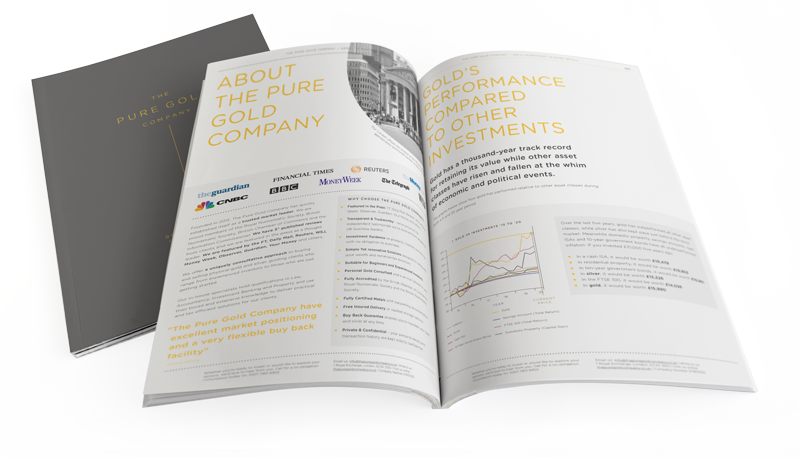The spectre of negative interest rates first reared its head in October and came to the fore again last week when the Bank of England asked lenders whether their systems were prepared for that eventuality. The Bank of England did also say banks shouldn’t take the information request as a sign a rate cut is imminent or would definitely happen, but it is an option and one worth understanding. So, what are negative interest rates and what do they mean for the assets in your portfolio? Are there steps investors can take to protect their investments and how can gold help?
Negative interest rates
The interest rate set by the Bank of England monetary policy is the rate of interest the central bank pays to commercial lenders who deposit money with them. This influences the rate at which banks lend to consumers and businesses. When interest rates are high it encourages people to save, while low-interest rates increase the incentive to borrow and spend.
For the fifteen years prior to the financial crisis of 2008, interest rates fluctuated wildly between 3.5% and 6% and were at 5% when Lehman Brothers collapsed in September 2008. With a series of swingeing cuts, the rate fell to 0.5% by March 2009 and has stayed around that level for the past decade.
Cutting or raising the base rate is one cornerstone policy action that the BoE uses to influence the direction of the economy. The UK Government has set an inflation target of 2%, so to influence consumer demand, the Bank of England will raise rates to cool spending and lower rates to try to boost economic activity.
With interest rates already so low, this particular instrument has been blunt for many years. At the start of the coronavirus pandemic, the BoE cut rates to just 0.1% and now they are considering turning negative.
Negative interest rates mean lenders would pay the Bank of England to keep their money, penalising them for holding onto cash and hopefully prompting them to lend to consumers and businesses to kick-start the economy. Theoretically, consumers should then pay the banks to deposit money with them. In practice, this cut is unlikely to be passed on to consumers quickly. If fewer people choose to deposit their cash with the bank, they could look at ways to recoup the loss of income through other means like fees.
Do negative interest rates work?
With rates so low, the BoE needs other weapons in its arsenal to fight inflation and try to manage the economy onto an even keel. Quantitative easing, in which the Bank of England buys up UK government bonds to put more money into circulation to restart the economy (a process that effectively ‘prints money’) has been going on for many years.
Quantitative easing was introduced precisely because with interest rates being so low post-2008, the central bank had no other effective way to influence economic activity. If banks actually lend out the ‘new money’ rather than hold onto it as excess reserves, then it may help in the short term to boost economic activity.
Quantitative easing programs can also lead to higher inflation and potentially affect currency value. If cutting rates leads to higher inflation without the anticipated increase in economic activity, this is called stagflation and can be very damaging for an economy.
Negative interest rates are the last resort for central banks that have cut their rates to the bone already. Denmark has had negative interest rates since 2012, and many banks now pass this on to consumers with deposits above a certain threshold. The EU central bank rate is also below zero as is Japan, Sweden and Switzerland. There are advocates and detractors for every policy decision, and it is not clear whether negative interest rates in the UK would have the desired effect.
Azad Zangana, senior economist and strategist at Schroders says: “The evidence from Europe does not really suggest that negative interest rates encouraged greater lending activity. In fact, lending was stagnant until the European Central Bank started its own funding for lending scheme. If banks are charged for holding cash reserves with the central bank, rather than being paid, then it eats into their profit margin and requires them to recoup the cost in some way.”
How will negative interest rates impact investments?
The key impact is clearly on bank deposits. If investors hold some assets in cash for liquidity reasons, it will become more expensive to do so with negative interest rates. That said, bank deposit rates have been so poor for so long, it’s unlikely anyone is using them for a return anyway.
For stocks, a lower interest rate should encourage companies to borrow to invest, which would be good for their growth. It could also encourage reckless spending so it’s important to continue to assess the risk of any investment decision.
Negative interest rates will go some way to propping up the property market if banks are minded to provide more competitive mortgage rates. There is little likelihood that any lender would offer a mortgage with a negative rate, but lower rates will attract more buyers.
That said, the property market is coming off the boil ahead of the end of the stamp duty exemption holiday. In addition, the full unemployment effects of the end of the furlough scheme are yet to be felt, so there are many factors affecting the health of the property market at the moment.
Is physical gold a good investment for 2021?
Gold provides no yield, its value is linked entirely to the gold price, which can make interest-bearing investments more attractive depending on your investment strategy. In a negative interest rate environment, the detriment of gold’s lack of yield is no longer relevant. Gold’s intrinsic value and the expectation that the gold price will rise propels the precious metal’s desirability.
The other attraction of gold is that if the policy works to the central bank’s plan, inflation will rise, and gold is well known for being an inflation hedge. That’s not an absolute given, but if prices are rising, often so is the price of gold.
All investment decisions need to be considered in the context of the broader economic climate, which remains fragile and uncertain. Negative interest rates are a tool in the Central Bank’s arsenal but the effect of its use, to lift inflation and provide stimulus to the sluggish economy, is not guaranteed.
The Bank of England may also decide not to lower interest rates below zero, but for now, it is on the table and the mere possibility of the action will be affecting decisions by companies, banks, property buyers and consumers. In these uncertain times, safe-haven gold is an important part of a balanced investment portfolio.


